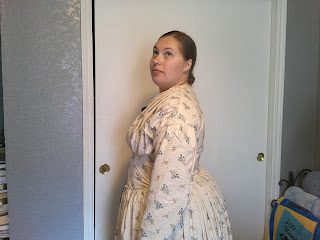Both are made from Timely Tresses' Lydia Alma bonnet. I was confused with the sizing on the pattern and ended up making a very small size on the first go around. I got the form all the way complete before I noticed.
Fortunately, I had plenty of buckram so I just made the next size up, which was exactly what I wanted. I spent the better part of a day on it, but millinery is fairly mindless work (although it isn't very elegant to work on, as working on 3D pieces isn't always so graceful!) so it went together fairly easily. The silk is from Ebay, leftover from another project. All the trimmings come from Timely Tresses as well, and I used fewer than I thought I needed. I opted to not put trimmings inside the bonnet as I am not a fan of the rustling sounds near my ears-it makes hearing somewhat difficult in my opinion. But that's just fine-there are examples of original bonnets without trimmings.
 |
| Some bonnets with interior trimmings, some without. |
As for the second bonnet, I just couldn't let it go to waste. My friend Paula has her bonnets custom made a bit smaller than average so I thought that it might make her a good 1840s bonnet. I asked if she wanted it and then recovered it with what I had in the stash. Paula picked out the pink ribbons to go with the black silk. I think that color combination looks fantastic!
Hopefully the craziness will die down by November so we can wear them to Landmark Inn!
Enjoy!


















































